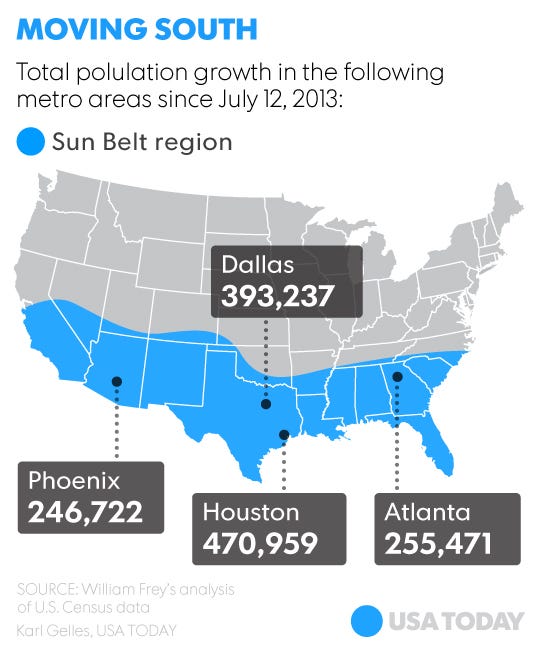Census: More Americans again moving to Sun Belt, suburbs

The USA’s recession-hit Sun Belt continues to thaw out, new data from the U.S. Census Bureau show, with Americans moving once more to places like Tampa, Dallas, Las Vegas, Phoenix and Atlanta.
At the same time, big cities like New York, Los Angeles, Washington, D.C., and Chicago are watching their overall population growth slow, even as they attract more immigrants than smaller towns and cities. A few cities, such as Pittsburgh, Cleveland and Youngstown, Ohio, have seen mostly losses for the past 15 years.
“I think the employment opportunities in the Sun Belt are coming around again,” said Brookings Institution demographer William Frey, who closely follows the phenomenon.
Frey analyzed three years of Census data and found that Sun Belt cities, which took a serious hit from the mortgage crisis and recession, were among the fastest growing in the nation in 2015.
While overall rates of people moving from one area to another remain down from pre-recession levels, Frey noted, Americans are moving at higher rates in several geographic regions, a big change from just two years ago.
“It seems like the beginning of a longer-term trend,” he said.
Among the fastest growing metro areas from 2013 to 2015:
- Houston, which grew by nearly 471,000
- Dallas-Fort Worth and Arlington, Texas, which grew by more than 393,000
- Atlanta, Sandy Springs and Roswell, Ga., which grew by more than 255,000
- Phoenix, Mesa and Scottsdale, Ariz., which grew by nearly 247,000

“People who do move, they’re moving to these places that are starting to rev up again,” he said.
The data show growth slowed in the greater New York area, as well as Chicago and its surrounding areas and Washington, D.C., and its suburbs.
Though metro Chicago continues to see a growing wave of new immigrants, Frey noted, it is also losing population to other areas. The end result: a one-year loss of more than 6,000 residents, the first in a generation.
As Millennials get older and start families, they’re giving another area a demographic boost: suburbs.
Many suburbs are now growing more quickly than far-flung “exurbs,” the new data show. Urban core areas, which as a group saw their populations balloon until 2012, are flattening as Millennials move out.
“Young people are what make suburban areas grow,” Frey said. “Young adults, as they move there, as they start having kids, as they start wanting to be in a more spacious place — that’s the traditional rise of the suburbs.”